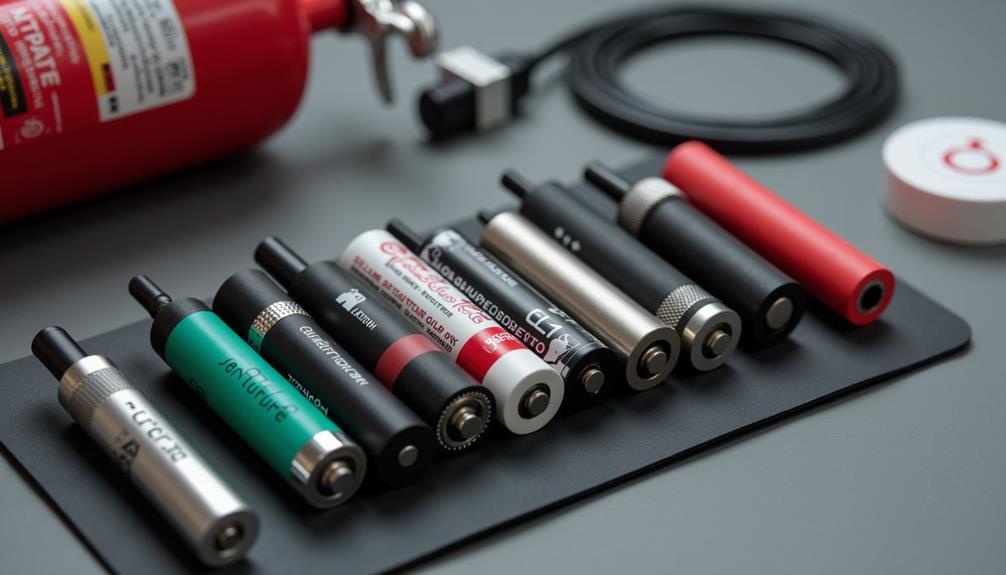Understanding Vape Batteries and Safety
- Posted on
- 0

Understanding Vape Batteries and Safety
Understanding vape batteries is essential for safe and effective use of vape devices. Types and specifications, such as 18650 and 21700, impact performance, so choose the right battery for your mod. Common risks like overheating and short circuits can be avoided with smart charging solutions and proper storage.
Make sure you use protective cases and charge on a stable surface. Regular inspections and maintaining cool storage conditions prolong battery life and safety. Adhering to industry standards and guidelines helps reduce injury risks. If you want to minimize issues, handle your batteries with care and follow manufacturer guidelines—keeping them safe extends their lifespan.
Key Takeaways
- Choosing the right battery type (e.g., 18650, 21700) and specifications is crucial for optimal device performance and safety.
- Proper charging practices include using the correct charger, monitoring the battery's state of charge, and avoiding overheating or overcharging conditions.
- Regular inspections for damage and maintaining cool, dry storage conditions can prevent battery-related incidents and prolong battery life.
- Utilizing protective measures such as battery cases and maintaining awareness of potential risks (e.g., short circuits, explosions) enhances safety.
- Adhering to industry standards and regulations, along with continuous user education, significantly reduces the risk of battery-related injuries.
Mechanics of Vape Batteries
When you vaporize, the power source that makes it all happen is the vape battery. These batteries come in different types, shapes, and sizes. The most common ones are cylindrical and rectangular. Let's break down the basics to help you make the right choice. Coil resistance plays a significant role in battery performance, with lower resistance coils generally requiring more power and draining batteries faster.
Mechanics of Vape Batteries
Battery types are an important factor to take into account. The most popular types are cylindrical and rectangular. Cylindrical batteries, like the 18650 and 21700, are the industry standard. Rectangular ones are less common but still used in some devices. Each type has its unique characteristics and applications.
Voltage levels are also vital. Batteries are rated for voltage (V) and discharge current (C). The voltage determines the power output, while the discharge current determines how much current the battery can safely supply. For example, a battery with a high voltage can deliver more power, but it might also drain faster.
Common Battery Risks
You'll want to stay alert for several risks when using vape batteries. One primary concern is overheating incidents. If your vape battery gets too hot, it can suffer from reduced performance or even lead to battery explosions. These risks are more common if you expose the battery to extreme temperatures or store it improperly.
Another common risk is battery explosions. This can happen if the battery comes into contact with metal objects like keys or coins, causing a short circuit. Always keep your batteries in a protective case and avoid storing them in pockets or bags where they might make contact with other items.
Additionally, using damaged batteries can lead to accidents. Avoid batteries with frayed or damaged casings, as they are more prone to issues. Charging your battery correctly and not leaving it unattended while charging are also important to prevent overheating and explosions. Staying vigilant about these risks will help guarantee your vaping experience is safe and enjoyable.
Safety Enhancement Measures
To mitigate potential risks, employing safety enhancement measures is essential. Vape battery technology has advanced considerably, incorporating various safety features to protect users. These innovations include built-in protection circuits, smart chargers, and better battery durability.
One effective measure is using smart chargers that can detect when a battery is fully charged and automatically stop charging to prevent overcharging. Moreover, opting for devices with embedded batteries can greatly reduce the risk of user error.
| Measure | Description | Benefit |
|---|---|---|
| Smart Chargers | Automatically stop charging when full. | Prevents overcharging. |
| Embedded Batteries | Non-removable by the user. | Minimizes user error. |
| Battery Cases | Protect batteries from damage. | Prevents short circuits. |
| Cool Storage | Stores batteries away from heat sources. | Reduces overheating risk. |
Proper Handling Tips
Proper handling of vape batteries is vital to guarantee safety and prolong their lifespan. When you're using your vape device, it's important to be mindful of how you handle the battery. First and foremost, check your battery types before using them. Most vape devices use Lithium-ion batteries, which are generally safe but can be risky if mishandled. Be sure to use the correct charging cable and charger, as incorrect voltage ratings can cause serious issues. Store your batteries in a cool, dark place to prevent overheating and damage.
Always inspect your batteries regularly for any signs of damage, such as dents, tears, or leakage. If you spot any damage, it's best to discard the battery immediately. Don't mix and match batteries and chargers from different suppliers, as this can lead to compatibility issues. When storing batteries for long periods, make certain they are in a battery case to protect them from other objects that could cause a short circuit.
Battery Charging Guidelines
When charging your vape batteries, following precise guidelines is key to safety and performance. To guarantee you get the most out of your batteries and avoid any potential hazards, it's important to know how to charge them correctly.
Here are three crucial tips to keep in mind:
-
Use the correct charger: Only use the charger provided with your vape battery or one specifically designed for your battery type. Mixing chargers can lead to voltage mismatches, causing batteries to overheat and potentially explode.
-
Avoid overcharging: Charging your battery overnight or leaving it unattended can cause overcharging, which can lead to overheating and damage. Try to charge your battery when you can keep an eye on it.
-
Maintain ideal voltage: Keep your device between 50 and 115 degrees Fahrenheit to prevent extreme temperature issues. Do not leave your device in a hot car or direct sunlight.
Storage and Maintenance
Store your vape batteries in a cool, dry place away from direct sunlight and other heat sources. This helps prevent overheating, which can reduce the battery lifespan. Ideal conditions for storage are usually between 50 and 115 degrees Fahrenheit. Make sure to store them away from any flammable materials and avoid stacking batteries on top of each other, as this can cause them to short circuit.
When you're not using your batteries, store them in a battery case. This protects them from coming into contact with metal objects in your pocket or bag, which can cause sparks and lead to dangerous situations. Furthermore, keep an eye on your batteries for any signs of damage, such as cracks, dents, or frayed wrapping. If you notice any damage, it's best to stop using the battery immediately to avoid any potential hazards. Regularly inspecting and properly maintaining your vape batteries will guarantee they last longer and stay safe to use. By following these simple steps, you can enjoy your vaping experience without worrying about battery safety.
Industry Standards and Regulations
When you explore the world of vape batteries, it's important to know about the industry standards and regulations that guarantee your safety. Regulatory bodies, like the Food and Drug Administration (FDA) and the International Organization for Standardization (ISO), enforce compliance standards that manufacturers must follow. These standards cover aspects like safety certifications, quality assurance, and consumer education.
Here are a few critical points about these regulations:
- Safety Certifications: Manufacturers must obtain necessary safety certifications, such as UL (Underwriters Laboratories) certifications, to guarantee their products meet minimum safety requirements.
- Compliance Standards: Regulatory bodies set compliance standards that mandate constant testing protocols and risk assessments to prevent potential hazards.
- Manufacturer Responsibilities: Manufacturers are responsible for providing clear guidelines and warnings, and they must adhere to rigorous quality control measures to safeguard consumers.
These regulations help protect you from potential risks and guarantee that your vaping experience is as safe as possible. By knowing these standards, you can make informed decisions and enjoy a safer, more responsible vaping experience.
Reducing Injury Risks
When using vape batteries, it's vital to understand injury prevention strategies to guarantee a safe vaping experience. Proper vape battery education can help you avoid common pitfalls.
| Safety Tip | Explanation | Benefits |
|---|---|---|
| Store safely | Keep batteries away from metal objects in cool, dry places. | Prevents short circuits and fires. |
| Inspect regularly | Check for damage, such as dents or frayed wraps. | Detects issues before they escalate. |
| Charge correctly | Use the right charger, avoid overcharging, and charge on a flat surface. | Minimizes overheating and explosions. |
| Handle with care | Be gentle when inserting or removing batteries. | Prevents physical damage. |
| Dispose properly | Dispose of batteries safely and according to guidelines. | Reduces environmental and health risks. |
Frequently Asked Questions
Can Vape Batteries Be Recycled?
Yes, you can recycle vape batteries. Properly recycling them reduces environmental impact and keeps hazardous materials out of landfills. Check with your local recycling center or vape shops for specific guidelines on vape battery recycling.
How Do Temperature Changes Affect Battery Life?
Temperature extremes can greatly affect your vape battery performance and lifespan. Always follow safety precautions and proper charging practices to manage thermal stress, ensuring your battery stays healthy and lasts longer.
Are Vape Batteries Safe Around Pets?
Keep vape batteries out of reach from pets to avoid hazards. If your pet ingests a battery, it can cause serious harm. Keep your pets safe by storing vape batteries securely.
Can Vape Batteries Be Used in Non-Vape Devices?
Using vape batteries in non-vape devices can be risky due to compatibility issues. They can cause overheating, explosions, or malfunctions, so it's best to stick with the manufacturer's recommendations for safe usage.
How Often Should Vape Batteries Be Replaced?
You should replace your vape battery every six months to a year, but it depends on usage. Good battery maintenance can extend the lifespan, so store them cool and dry, and avoid overcharging.
Conclusion
To summarize, you now know a lot about vape batteries and their safety. By following the safety tips, you'll avoid risks and prevent accidents. Proper handling, charging, and storage are key. Always use the right charger and avoid putting batteries in your pocket. If you see any damage, replace the battery. By being careful, you'll enjoy a safe vaping experience. At K Town Vape, we prioritize your safety and offer a wide selection of high-quality vape battery accessories to ensure your vaping experience is both enjoyable and secure.


Comments
Be the first to comment...